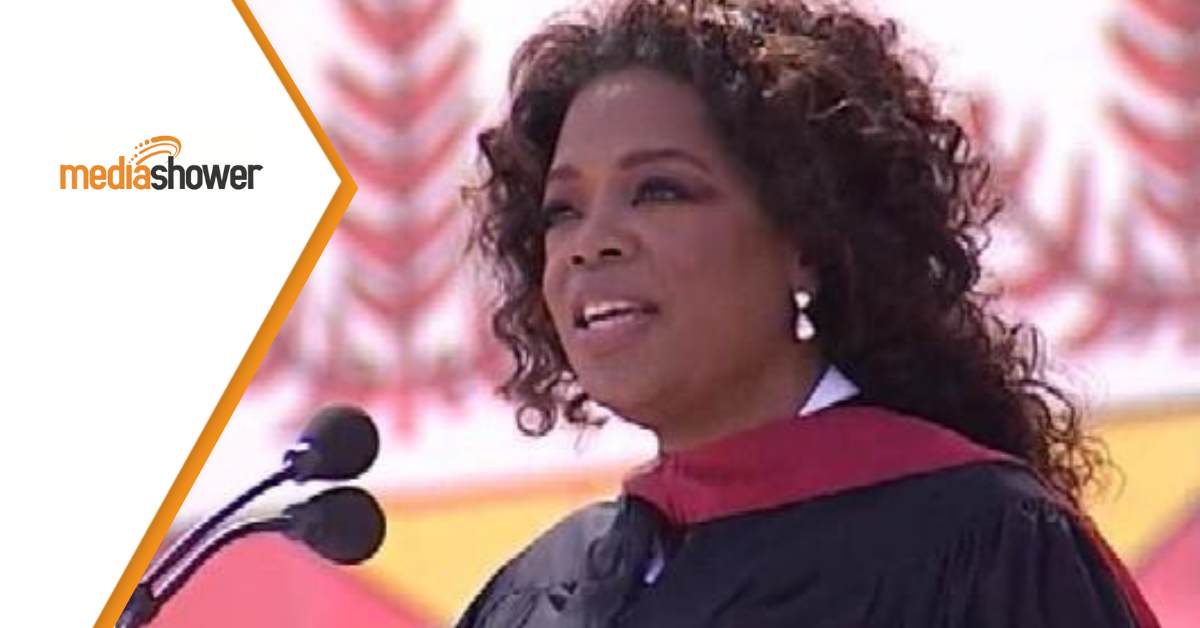
TLDR: In her 2008 Stanford University Commencement Speech, Oprah Winfrey encouraged the audience to listen to their feelings, learn from failures, and focus on serving others to fill their lives with meaning and happiness. Throughout the speech, she told personal stories to build emotional connections with her audience.
So what?: It’s an outstanding example of simple, effective communication based on emotional connections, rapport, and storytelling. It teaches professional communicators the value of authenticity, resilience, and entertainment.
Be Authentic
“I’m not going to change my name. And if people remember it or not, that’s okay.”
Takeaway: Authenticity is the hallmark of great communication.
No one else could give this speech but Oprah. Audiences have a sixth sense for authenticity, and they respond to it positively. Authentic communication sparks credibility and builds trust. Trust then leads to an emotional connection and openness to engagement.
Being inauthentic doesn’t feel right – for the communicator, or for the audience.
Oprah says she didn’t like her name but was not about to sacrifice it on the altar of success.
“So, I grew up not loving the name, but once I was asked to change it, I thought, well, it is my name, and do I look like a Suzie to you? So, I thought, no, it doesn’t feel right.”
Instead, despite her dislike of her name, Oprah embraced it. This willingness to embrace discomfort in exchange for real authenticity has helped Oprah make emotional connections over and over throughout her career.
Authenticity isn’t always easy, revealing some hidden flaw, whether perceived or real, can make us question ourselves. As Oprah has shown, getting past that can build trust in ourselves, helping us to make connections with others.
Tell Stories
“So, they sent me to a salon where they gave me a perm, and after a few days, all my hair fell out, and I had to shave my head. And then they really didn’t like the way I looked.”
Takeaway: Personal stories and skillful storytelling make you relatable.
Authenticity sets the stage for deep human connections. Skilled orators resort to storytelling in speeches to trigger these connections. We’re all hardwired through cognitive and emotional mechanisms to listen to and appreciate stories.
In her Stanford commencement speech, Oprah uses this primal channel for human connections to relay the story of her goddaughter, who is among the ranks of the graduates, and several events from her past.
She skillfully diffuses her celebrity status through self-deprecating humor, like the story about her bad hair day.
Oprah’s personal stories lend substance to the advice she dispenses above the emotional connections they help build. Personal narratives in speeches trigger empathy, identification, engagement, and attention while improving retention and memory.
Inspire Others
“And after eight months, I lost that job. They said I was too emotional. I was too much.”
Takeaway: Your failures carry powerful lessons for you and others.
Throughout our lives, we build a reservoir of experiences through our successes and failures. Young people can build such a reservoir early in life, through the experiences of mentors or other people they respect.
In her commencement address, Oprah provides accounts of her experiences and failures to serve as inspiration for those in the audience. She recounts how she lost her job as an anchor due to being overly emotional.
She treats the setback as a learning opportunity. She tells the audience how losing one job led to another chance, a new opportunity she seized without compromising her authenticity.
Build Emotional Connections
“So, I’d go home at night and fill up my journals about how miserable I was and frustrated. Then I’d eat my anxiety.”
Takeaway: Emotional resonance is the key to long-term retention.
Why do we remember things that touch us emotionally? Emotions activate a part of the brain that stimulates the memory. The brain then perceives these emotionally impactful memories as high-priority information, allocating more cognitive resources to their encoding.
So, a touching personal story literally builds emotional connections in the brain.
Oprah exploits emotional resonance throughout her speech, masterfully playing with its intensity as she delivers her message.
- Before the 3:10 mark, she lays the groundwork for what’s to come. She strikes up emotional connections with the audience through her story about her goddaughter. The emotional intensity of the introductory part of her speech is about five on a scale of one to ten.
- From 3:10 to 6:30, she discusses her graduation struggles and interactions with her father, taking the emotional intensity up to about seven.
- Up to the 13:30 mark, she discusses her failures and the lessons they taught her. Her emotional resonance drops slightly during this segment, setting the stage for the part of the address dealing with success.
- From about 14:00 to the beginning of her closing remarks, her success stories amplify the emotional resonance of the speech to about 9/10. She encourages her audience to listen to their feelings and do what feels right. She quickly rattles off advice, riding the emotional tides she has created. The story of her South African school project disappointment briefly interrupts the flow of positive emotions. This brief pause spring-loads the emotional flow, boosting positivity as she discusses the lessons the ordeal taught her.
- The closing remarks, including her passionate call to action, mark the emotional peak of the speech. Using emotions to make an impact and cement the conclusion of her address, she encourages the audience to focus on serving others as a way of living a fulfilling, rewarding, and happy life.
Provide Value
Takeaway: Give the audience something they can do.

Igniting all the emotional capital she has accumulated throughout her address, Oprah delivers an explosive call to action. Through it, she dispenses practical advice, telling the graduates unequivocally what she thinks they ought to do.
“So, whatever field you choose, if you operate from the paradigm of service, I know your life will have more value, and you will be happy.”
Choose meaningful service, she says, evoking her own experience with philanthropy. By doing so, you can turn your job into a gift that keeps on giving while filling your life with meaning, direction, and purpose.
She continues to deliver value by cautioning the audience to steer clear of the “helper’s high.” There should be nothing self-serving about helping others, she says, not even the tide of positive emotions serving can create.
These are powerful words of advice from someone with plenty of experience serving others and improving lives.
Marketers’ Takeaways
These are your communication lessons from Oprah’s 2008 Stanford Commencement Speech:
- Be authentic. By assuming your identity and standing up for your values, you inspire trust and engagement in your audience. Authenticity is key to building meaningful connections and placing your message on solid foundations.
- Tell personal stories. Storytelling is one of the top motivational speech techniques. Relevant personal stories resonate with audiences, engaging people and making your message relatable.
- Learn from setbacks. Failures are learning opportunities. Orators who analyze their failures provide practical and memorable lessons to their audience.
- Connect emotionally. Build emotional connections by being authentic, telling personal stories, and using empathy. Emotional connections lend weight to your message.
- Provide value. Give people something they can do to obtain a desirable effect. Make your advice powerful and credible.
Want to communicate like Oprah? Our AI-powered marketing platform makes great communication easy. Click for a 14-day free trial.